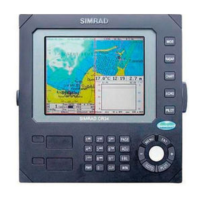CR44/54 Radar menu Chapter 3-5
3.1.6 Sea return
Not all radar echoes are produced by hard navigation items such
as boats, buoys and land. Some radar echoes may be received from
irregularities on the surface of the water, particularly at close range by
breaking wavecrests, particularly in windy weather and in heavy seas.
These echoes appear on the radar screen on the very short range
scales as multiple small echoes next to own ship. Under high winds
and extreme conditions the echoes from sea clutter may appear as
dense background of clutter forming the shape of an almost solid
disc, as far as one to three miles in all directions from own ship, but
the worst area is where the wind is blowing towards the ship. The
radar has a sea clutter control, sea (STC), which can be used to mini-
mize the effects of sea clutter pickup on the screen.
3.1.7 Storm and rain squall returns
The radar can also see echoes from rain or snow. Echoes from storm
areas and rain squalls consist of countless small echoes, continuously
changing in size, intensity, and position. These returns sometimes
appear as large hazy areas on the display depending on the intensity
of the rainfall or snow in the storm cell. The cells usually may be
visible at long distances due to their high altitude above the radar
horizon and are very helpful for observing potential bad weather
conditions. If the returns from storm areas and rain squalls are not
desired, the RAIN clutter control can be adjusted to minimize the
effect on the radar screen.
3.1.8 Blind sectors or shadow effect
Funnels, masts or derricks, (when located near the antenna array)
may cause shadows. Shadow areas can be recognized since beyond
the obstruction there will be a reduction of targets and noise inten-
sity, although not necessarily a complete cutoff seen on the screen.
However, if the shadow angle is more than a few degrees, there will
be a blind sector.
In some shadow sectors the beam intensity may not be sufficient to
obtain an echo from a very small object even at close range, despite
the fact that a large vessel can be detected at a much greater range.
For this reason, the angular width and relative bearing of any shadow
sector should be determined at installation. Sometimes shadowing

